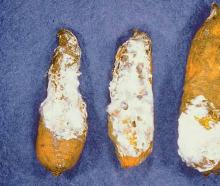See:
Lettuce (Lactuca sativa) - Drop (Sclerotinia Rot)
Cause Sclerotinia sclerotiorum, or S. minor, both soilborne fungi that overwinter as sclerotia. The disease sometimes is severe on stored carrots. Sclerotinia sclerotiorum is common in soils in the Pacific Northwest and other host plants include potato, beans, lettuce, parsnips, cabbage and other crucifers, and cucurbits.
Symptoms Cottony white mycelium on surface of soft lesions on the root.
Cultural control
- Rotate crops: grow nonsusceptible crops (grasses and cereals) for 2 years before planting susceptible crops (beans, lettuce, parsnips, crucifers, celery).
- Do not grow early or late crops in fields with a history of this disease because heavy rains can cause severe losses.
- Clean and disinfect bins between storage seasons. Store in a dry or sunny location when not in use.
- Ensure correct storage conditions, which include a temperature near freezing and humidity of 85% to 90%. Store carrots in tote bins rather than bulk piles to allow better air movement.
Chemical control
- Postharvest soaks:
- Mertect 340-F (Group 1) at 41 fl oz/100 gal water. Soak carrots 5 to 10 sec before storage.
Biological control
- Bexfond at 7 to 14 fl oz/A. 4-hr reentry. O
- Serenade Opti at 14 to 20 oz/A on 7- to 10-day intervals. Applications can be made up to and the day of harvest. 4-hr reentry. O
- Stargus at 2 to 4 quarts/A plus a nonionic surfactant on 7- to 10-day intervals. Preharvest interval is 0 days. 4-hr reentry. O
References Finlayson, J.E., Rimmer, S.R., and Pritchard, M.K. 1989. Infection of carrots by Sclerotinia sclerotiorum. Canadian Journal of Plant Pathology 11:242-246.
Kora, C., McDonald, M.R., and Boland, G.J. 2003. Sclerotinia rot of carrot: An example of phenological adaptation and bicyclic development by Sclerotinia sclerotiorum. Plant Disease 87:456-470.



